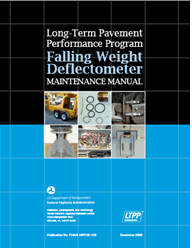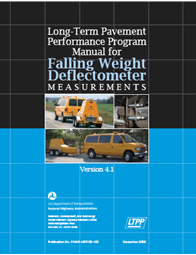U.S. Department of Transportation
Federal Highway Administration
1200 New Jersey Avenue, SE
Washington, DC 20590
202-366-4000
Federal Highway Administration Research and Technology
Coordinating, Developing, and Delivering Highway Transportation Innovations
|
LTPP News This newsletter is an archived publication and may contain dated technical, contact, and link information. |
|
| Publication Number: FHWA-HRT-08-032 Date: Fall 2007 |
Publication Number:
FHWA-HRT-08-032
Issue No: Vol. 3 No. 3 Date: Fall 2007 |
| Email Distribution List |
|
| Contact |
Customer Service
|
In 2009, the Long-Term Pavement Performance (LTPP) program will reach its 20-year milestone of collecting pavement performance data from nearly 2,500 test sections across North America. However, due to budget reductions to the program, some of the original objectives of the LTPP program will not be met by 2009. As a result, the Federal Highway Administration (FHWA) management has begun planning for the transition of the program post-2009 so that some of the activities not completed by this date can be completed in some formal capacity after the official end of the program.
FHWA drafted a post-2009 document that addresses such questions as “What happens to the LTPP test sites that have not reached the end of their design life?” and “How do we keep the LTPP database current with technology so that it is available to generations to come?” FHWA management in collaboration with the Transportation Research Board (TRB) LTPP Committee is working on possible solutions to address these and other issues identified in the post-2009 document.
For more information, contact Aramis López at aramis.lopez@ dot.gov or (202) 493-3145.
Over the past several years, LTPP has been working to enhance its software used to process traffic data from the LTPP test sites. The LTPP Traffic Analysis Software (LTAS) uses a variety of Quality Control (QC) checks to review the data before it is loaded into the LTPP pavement performance database. The twelve QC checks performed by the LTAS software, which are output graphically, include:
Automated Vehicle Classification (AVC) Data:
Weigh-In-Motion (WIM) Data:
Comparison of AVC and WIM Data:
In addition to the QC graphs, LTAS has reports that can provide assistance in looking at the data to determine its accuracy. Some of these reports are:
For sufficient data, LTAS allows review of loading data at the daily or weekly level. Sufficient data is a minimum of 100 vehicles or 100 axles for the time period being used. LTAS has the capability of producing different graphs. For example, a user can use the software to graphically review monthly or quarterly GVW data. In terms of volume, week-to-week comparisons for a month can also be reviewed graphically. LTAS can also be used to view trends over time by using a year-to-year comparison graph.
Although LTAS is still going through further enhancements, it is available upon request through the LTPP Customer Support Service Center. Keep in mind that although the software is available upon request, support with how to use the software is not available. Also, ORACLE software is needed to run LTAS.
For more information, contact Deborah Walker at deborah.walker@ dot.gov or (202) 493-3068.
Periodically, LTPP will share database tips to give its users a better understanding of how the database works. This issue features tips on the LAB_CODE field and how to use external links to work with the database.
The LAB_CODE field is a four digit character field to help users identify where the laboratory is located and who performed the test. Using the STATE_CODE definition, the first two characters represent the State in which the laboratory is located. The third character indicates what laboratory performed the test (see shaded box below). And the fourth character represents the sample’s test number and is sequentially numbered from 1-9, then A-Z.
A novice database user can very easily use the Table Navigator software to identify who performed the laboratory test. This software is included in the Standard Data Release (SDR) and does not require the user to have any experience in combining tables or using Standard Query Language (SQL) to get the laboratory information. The user simply opens any TST table (that contains laboratory test results) and clicks the LAB_CODE field to find out who performed the test.
For example, LAB_CODE 4821 shows that the lab is located in Texas (48), the test was performed by the State (2), and this is the first test performed on the sample (1).
While all of the characters are general descriptor information, the third character tells the user who performed the laboratory test. FHWA lab contractors are required to follow certain data QC and Quality Assurance (QA) procedures set by the LTPP program office. However, the internal QC/QA practices for the State highway agencies and third-party contractors may be different from what LTPP requires. Therefore, the user should take this into consideration when analyzing the data.
Possible Selections for Third Character in LAB_CODE Field
|
Another helpful database tip explains how to use external links in a Microsoft® Access database to tables contained in other Access databases. This allows the user to run a query on tables contained in one database and bring in data from tables contained in other Access databases (modules).
For example, let’s say you want both the International Roughness Index (IRI) and 12-foot moving average profile data for Preventive Maintenance Effectiveness of Flexible Pavements test sections (Specific Pavement Study-3). All you need to do is create external links from the MONITORING databases to the databases that contain the profile data points. Then you run a query in the monitoring database that captures data from the other “linked” databases. Now this may be slower than creating a custom project database, but it works and it overcomes some of the issues with Access caused by having to divide the LTPP database into smaller than 2 gigabyte (GB) database modules.
Watch for more database tips in upcoming issues.
LTPP is working on creating new tables that can be used by State highway agencies for local calibration of the Mechanistic-Empirical Pavement Design Guide (M-E PDG). The first set of new tables created is for traffic data only. The “beta” traffic tables will be available January 2008 as part of SDR 22. LTPP plans to add other tables in the future to assist agencies with local calibration.
To request a copy of SDR 22, contact LTPP Customer Support Service Center at ltppinfo@dot.gov.
Ms. Jane Jiang has joined the LTPP Team and will be responsible for the information management portion of the program, particularly the LTPP database. With more than 14 years of experience in pavement engineering, Ms. Jiang has recognized expertise and extensive experience in many areas of pavement engineering, including: long-term pavement performance data modeling and statistical analysis;
M-E pavement evaluation and rehabilitation designs; life cycle cost analysis; falling weight deflectometer data analysis/ backcalculation; engineering software development; and traffic monitoring data analysis for M-E PDG. She can be reached by phone at
(202) 493-3149 or e-mail at jane.jiang@dot.gov .
If you are in Washington, D.C. for the 2008 TRB Annual Meeting, please make plans to attend the LTPP State Coordinators’ Meeting on Sunday, January 13, and the LTPP Box Session on January 14.
Sunday, January 13, 2008
9:30 a.m.-11:30 a.m., Marriott
Long-Term Pavement Performance State Coordinators' Meeting
William H. Temple, Louisiana Department of Transportation and Development, presiding
Sponsored by the TRB LTPP CommitteeAs in the past, this annual LTPP State Coordinators' Meeting provides an excellent opportunity for all attendees to discuss LTPP plans, progress, and experiences with Federal, State, provincial, industry, and academic colleagues. This year’s meeting includes presentations by State Coordinators from Connecticut, North Carolina, and Texas. They will discuss their agencies’ plans for their LTPP test sites after 2009, and what their roles should be at this time.
Monday, January 14, 2008
10:15 a.m.-12:00 p.m., Marriott
Long-Term Pavement Performance (LTPP): More Findings, More Products, More Tools
Larry J. Wiser, Federal Highway Administration, presiding
Sponsored by the TRB LTPP Committee
- Benefits of the LTPP Program
Newton C. Jackson, Nichols Consulting Engineers
- Findings from Pavement Subsurface Moisture Predictions Study
Jason Puccinelli, Nichols Consulting Engineers
- Findings from Pavement Subsurface Frost Predictions Study
Olga I. Selezneva, Applied Research Associates, Inc.
- Products Ready for Use and Products Currently Underway
Antonio Nieves and Michael M. Moravec, Federal Highway Administration

Long-Term Pavement Performance Program Falling Weight Deflectometer Maintenance Manual
FHWA-HRT-05-153. This document provides FWD owners, operators and technicians information on maintenance guidelines, based on continuous operation of the LTPP program’s FWDs.

Long-Term Pavement Performance Program Manual for Falling Weight Deflectometer Measurements
FHWA-HRT-06-132. This manual is intended for use in collection of FWD data for the LTPP Program. As such, it contains background information on FWD equipment and the general role of FWD testing within LTPP as well as a set of field operations guidelines for the data collection process.
For more information about the LTPP Program, visit
www.fhwa.dot.gov/pavement/ltpp/.